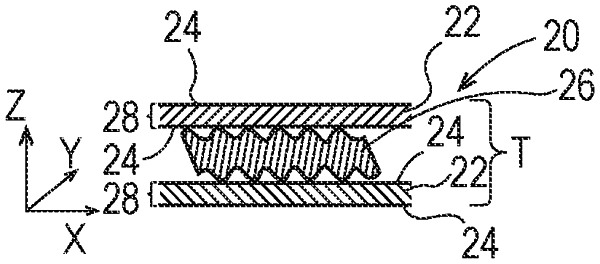| CPC B32B 5/145 (2013.01) [B31F 1/16 (2013.01); B32B 5/08 (2013.01); B32B 5/26 (2013.01); B32B 27/10 (2013.01); B32B 27/12 (2013.01); B32B 27/32 (2013.01); B32B 29/02 (2013.01); D01D 5/18 (2013.01); D04H 1/26 (2013.01); D04H 1/407 (2013.01); D04H 1/425 (2013.01); D04H 1/4374 (2013.01); D04H 1/593 (2013.01); D04H 1/60 (2013.01); D21H 13/10 (2013.01); D21H 15/10 (2013.01); D21H 21/20 (2013.01); D21H 27/002 (2013.01); D21H 27/004 (2013.01); D21H 27/005 (2013.01); D21H 27/007 (2013.01); D21H 27/02 (2013.01); D21H 27/30 (2013.01); B31F 1/126 (2013.01); B32B 2250/20 (2013.01); B32B 2262/0253 (2013.01); B32B 2262/062 (2013.01); B32B 2307/54 (2013.01); B32B 2307/546 (2013.01); B32B 2555/00 (2013.01); D01D 5/0985 (2013.01); D04H 1/4218 (2013.01); D04H 1/4309 (2013.01); D04H 1/435 (2013.01); D04H 1/4358 (2013.01); Y10T 442/693 (2015.04)] | 20 Claims |

|
1. A multi-ply osmotic material-free article comprising:
a. a first ply comprising: a plurality of wood pulp fibers at least a first portion of which are present in the form of a wet laid fibrous structure and a plurality of filaments wherein at least a portion of the plurality of filaments are spun from a die and directly laid on top of the wet laid fibrous structure and wherein a second portion of the plurality of wood pulp fibers are commingled together with another portion of the plurality of filaments in the form of a coform fibrous structure such that the multi-ply osmotic material-free article exhibits; and
b. a second ply comprising a second wet laid fibrous structure comprising a plurality of wood pulp fibers associated with the first ply such that the multi-ply fibrous structure exhibits
a. one or more absorbent characteristics selected from the group consisting of:
i. HFS of greater than 17 g/g as measured according to the Horizontal Full Sheet (HFS) Test Method;
ii. CRT Rate of greater than 0.35 g/second as measured according to the Absorptive Rate and Capacity (CRT) Test Method;
iii. CRT Capacity of greater than 14 g/g as measured according to the Absorptive Rate and Capacity (CRT) Test Method;
iv. CRT Capacity of greater than 0.59 g/in2 as measured according to the Absorptive Rate and Capacity (CRT) Test Method; and
v. a Pore Volume Distribution such that greater than 15% of the total pore volume present in the multi-ply osmotic material-free article exists in pores of radii of greater than 225 μm as measured according to the Pore Volume Distribution Test Method; and
vi. a Pore Volume Distribution such that greater than 6% of the total pore volume present in the multi-ply osmotic material-free article exists in pores of radii of from 301 to 600 μm as measured according to the Pore Volume Distribution Test Method; and
b. one or more of the following article properties:
i. one or more wet strength properties selected from the group consisting of:
(1). Geometric Mean Wet TEA of greater than 30 g*in/in2 as measured according to the Wet Tensile Strength Test Method;
(2). Wet Burst: Dry Burst Ratio of greater than 0.5 as measured according to the Wet and Dry Burst Test Methods;
(3). Wet Burst Energy Absorption (BEA) of greater than 10 g-in/in2 as measured according to the Wet Burst Test Method;
(4). Wet MD Tensile of greater than 420 g/in as measured according to the Wet Tensile Strength Test Method; and
(5). Wet Burst of greater than 450 g as measured according to the Wet Burst Test Method;
ii. a VFS of greater than 11 g/g as measured according to the Vertical Full Sheet (VFS) Test Method;
iii. a Pore Volume Distribution such that greater than 5% of the total pore volume present in the multi-ply osmotic material-free article exists in pores of radii from 2.5 to 30 μm as measured according to the Pore Volume Distribution Test Method;
iv. one or more softness properties selected from the group consisting of:
(1) an Overhang Length of less than 10.6 cm as measured according to the Flexural Rigidity and Bending Modulus Test Method;
(2) a Plate Stiffness, Basis Weight Normalized of less than 0.20 N*mg/M as measured according to the Plate Stiffness and Basis Weight Test Methods;
(3) a Bending Modulus of less than 9.0 milligram·cm·grams/mils3 as measured according to the Flexural Rigidity and Bending Modulus Test Method;
(4) a TS7 Value of less than 17.0 dB V2 rms as measured according to the Emtec Test Method;
(5) a TS750 Value of greater than 20.0 dB V2 rms as measured according to the Emtec Test Method; and
(6) a Geometric Mean Dry Modulus of less than 2250 g/cm*% at 15 g/cm as measured according to the Dry Tensile Strength Test Method.
|